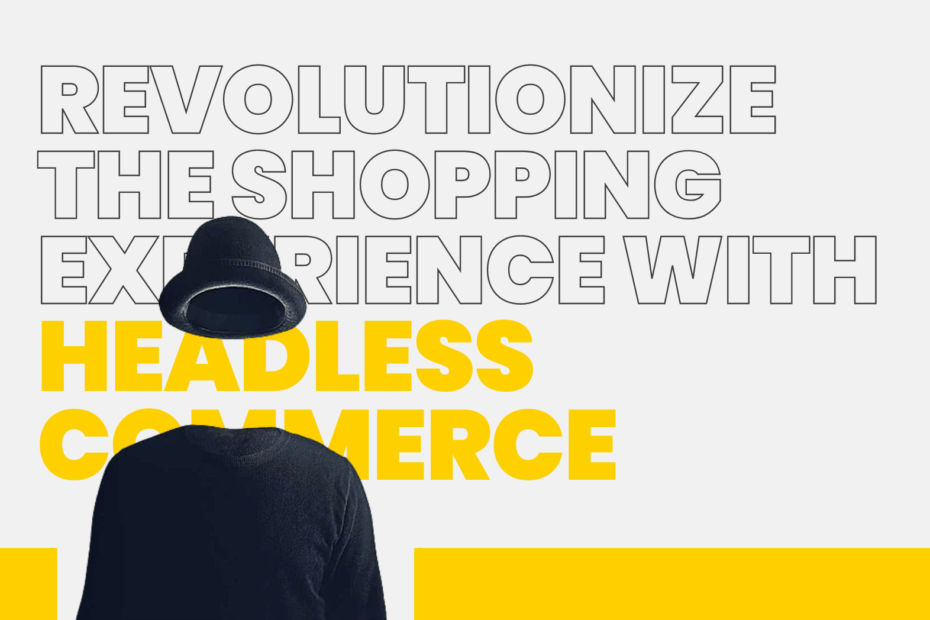Welcome to the world of headless e-commerce, where flexibility and scalability meet to create an unparalleled digital shopping experience! Are you tired of the limitations and constraints of traditional e-commerce platforms? Headless e-commerce is here to revolutionize the way you do business online. With the power to separate the front and back end of your e-commerce platform, you can now create a unique and personalized shopping experience for your customers while leveraging the security and robustness of a reliable e-commerce platform. Get ready to level up your online game and stay ahead of the competition with headless e-commerce.
The market for headless e-commerce is growing rapidly. According to a report by ResearchAndMarkets, the global headless commerce market size is expected to grow from USD 5.5 billion in 2020 to USD 27.5 billion by 2025, at a Compound Annual Growth Rate (CAGR) of 38.6% during the forecast period.
This growth can be attributed to several factors, such as the increasing adoption of headless e-commerce by businesses of all sizes, the growing need for personalized and engaging online shopping experiences, and the increasing use of emerging technologies such as artificial intelligence (AI) and machine learning (ML) to improve the customer experience.
Also, businesses are increasingly looking for a way to keep up with the fast-paced digital landscape and stay ahead of the competition, and Headless e-commerce is an ideal solution for this. The ability to create a unique and personalized shopping experience, the ability to easily integrate with existing systems, scalability, and the ability to leverage the latest technologies to improve the customer experience are all factors that are driving the growth of the headless e-commerce market.
What is Headless E-commerce and how does it work?
Headless e-commerce is an approach to creating digital shopping experiences that allow for greater flexibility and scalability. The concept came into the limelight recently when businesses felt the need to create an online marketplace and make their businesses more efficient by improving the consumer experience. The term “headless” refers to the separation of the front-end and back-end of an e-commerce platform. This means that the front end, or the user interface, can be built and customized independently of the back end, which manages the data and functionality of the platform.
The headless architecture allows businesses to create a unique and personalized shopping experience for their customers, while still leveraging the power and security of a robust e-commerce platform. This approach allows easy integration with existing systems, such as customer relationship management (CRM), Inventory management Systems, Marketing Automation Systems, Logistics and Shipping systems and Enterprise resource planning (ERP) systems.
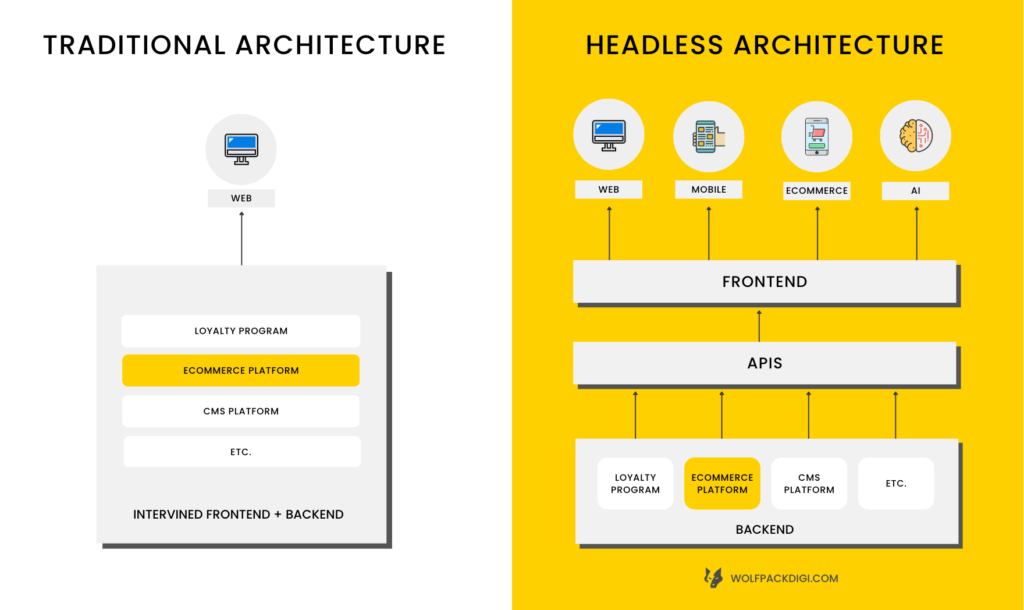
Headless e-commerce also offers many benefits for businesses looking to stay ahead of the curve when it comes to technology. By separating the front-end and back-end, businesses can take advantage of the latest technologies to improve their online shopping experience. For example, headless e-commerce allows businesses to create a responsive web design that is optimized for mobile devices, which is becoming increasingly important as more and more customers prefer to shop online using their smartphones.
Additionally, headless e-commerce allows businesses to leverage the power of emerging technologies such as artificial intelligence (AI) and machine learning (ML) to improve the customer experience. For example, businesses can use AI and ML to create personalized product recommendations, improve search functionality, and even offer real-time customer support. This helps to create a more engaging and efficient shopping experience for customers.
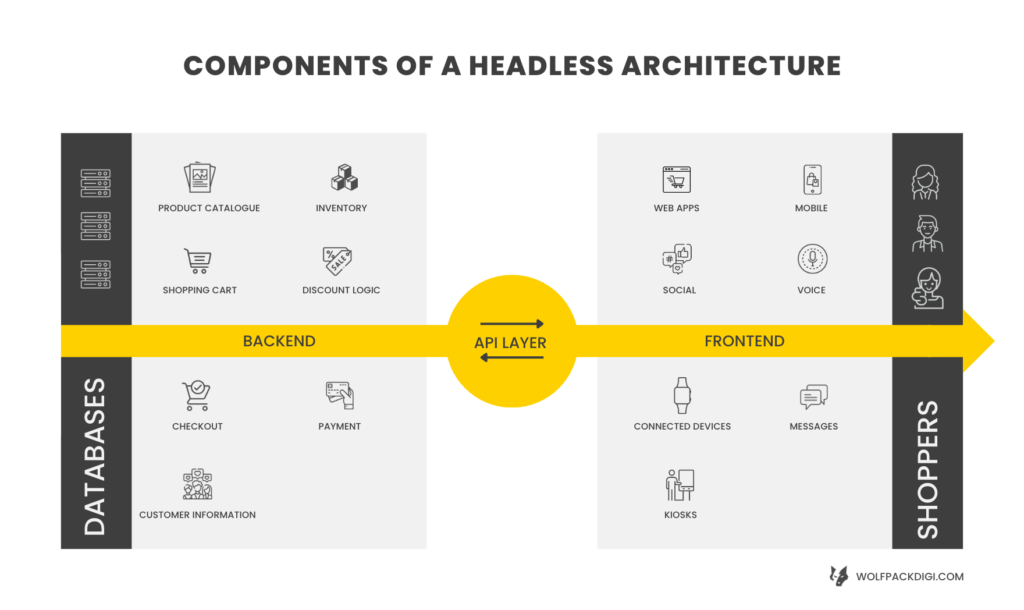
The Pros and Cons of Using a Headless E-commerce Platform
There are several advantages of using a headless e-commerce platform
- The first is the ability to create a unique and personalized shopping experience for customers. This can be done by creating custom user interfaces that are tailored to specific customer segments or product lines.
Glossier is one business that uses headless commerce to offer a customised purchasing experience. They make use of a headless commerce architecture, which gives them the ability to isolate the front-end e-commerce platform from the back-end website for customers. This makes it simple for them to test and improve the user experience, utilising information from the e-commerce platform to customise and inform the website. To make product recommendations and develop customised landing pages, for instance, companies collect information on consumer browsing and purchase history. Additionally, they customise email campaigns and other marketing initiatives using the information on client preferences and behaviour. Overall, Glossier can give its consumers a more smooth and more customised buying experience by employing a headless commerce strategy. - Headless commerce also has the ability to integrate with existing traditional systems easily. This allows businesses to leverage the data and functionality of these systems to create a seamless and efficient shopping experience for customers.
Under Armour is one example of a business that integrates with current systems via headless commerce. They link their e-commerce platform with their current systems for inventory management, customer relationship management, and marketing automation using a headless commerce strategy.
Under Armour is able to isolate the front-end customer-facing website from the back-end e-commerce platform thanks to the headless commerce architecture. As a result, they can quickly link their e-commerce platform with their current systems, including their inventory management system, and get real-time stock availability updates. In order to have more individualised marketing efforts, they also interface with their CRM to have a better insight into the behaviour and preferences of their clients.
- Another advantage of headless e-commerce is the ability to create better performance. By separating the front-end and back-end, the back-end can handle the data processing and business logic while the front-end can focus on rendering the data and creating a smooth user experience. This allows for faster loading times and a more responsive user interface, improving the overall performance of the e-commerce platform. This is especially beneficial for businesses that expect high traffic volume or want to target customers who are looking for high-performance websites.
Skullcandy used BigCommerce as their headless e-commerce platform and by creating custom user interfaces that are tailored to specific customer segments or product lines, they improved the website performance, resulting in a 30% increase in conversion rates and a 20% increase in revenue.
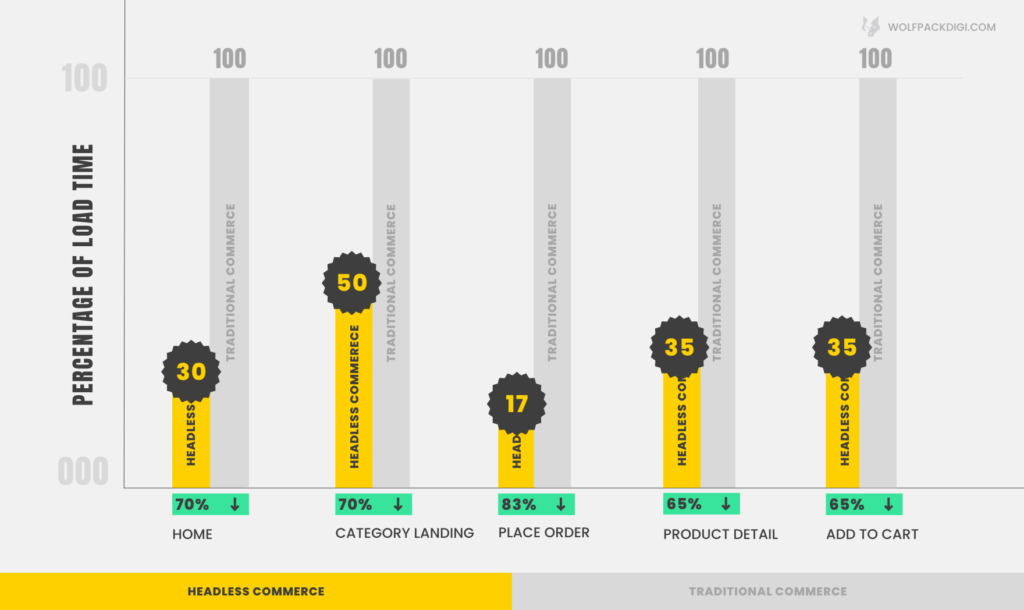
However, there are also some disadvantages to using a headless e-commerce platform:
- One of the biggest is the cost and complexity of development. Creating a custom user interface can be time-consuming and expensive, and it requires a skilled development team to implement.
- Another potential disadvantage is that headless e-commerce can be less user-friendly for content creators and marketers. Traditional e-commerce platforms usually provide a built-in content management system (CMS) that allows marketers to easily create and manage product pages, blog posts and other content. A traditional CMS may not have the scalability to handle the high traffic and data volumes that are possible with headless commerce, which can make it difficult for marketers to manage their e-commerce operations at scale. Also, A traditional CMS may not have all the functionalities that marketers may need for headless commerce, for example, for personalization and A/B testing.
- With headless e-commerce, businesses need to use external systems for content management which can be an added complexity.
- Furthermore, Headless e-commerce can also lead to increased hosting costs as it requires specialized hosting services and can also increase the need for more resources to handle the increased data flow.
How to Choose the Right Headless E-commerce Platform for Your Business
When choosing a headless e-commerce platform for your business, it’s important to consider the features that are important to you. Some of the key features to look for include:
- Customization options: The ability to create a unique and personalized shopping experience for customers.
- Integration capabilities: The ability to easily integrate with existing systems, such as Logistics and Shipping systems, Marketing Automation Systems, CRM and ERP systems.
- Scalability: The ability to scale the platform as your business grows.
- Security: The ability to keep customer data and transactions secure.
- Support: The availability of support and documentation to help you implement and manage the platform.
One of the best headless e-commerce platform comparisons is Commercetools, Magento (Adobe Commerce), BigCommerce, Shopify, Snipkart, Elasticpath, Saleor and many more.
1. Commercetools
This is a cloud-based e-commerce platform that offers a wide range of customization options and integration capabilities. It also has a modular architecture that allows businesses to easily add new features and functionalities to their platform. One of the companies that have successfully integrated Commercetools is Trivago, a global hotel search platform. They used Commercetools to create a personalized shopping experience for customers by integrating their existing CRM system with their e-commerce platform. This allowed them to provide personalized product recommendations and offers to customers based on their previous interactions with the brand.
2. Magento (Adobe Commerce)
This is a popular open-source e-commerce platform that is known for its flexibility and scalability. It offers a wide range of customization options and a large community of developers who can help businesses with their implementation. Ford used Magento to create a seamless shopping experience for customers. They integrated their e-commerce platform with their ERP system to ensure that customers could see real-time inventory levels and receive accurate delivery estimates.
3. BigCommerce
This is a SaaS-based e-commerce platform that offers a wide range of customization options and integration capabilities. It also has a robust set of built-in features that are designed to help businesses improve their online sales. One of the companies that have successfully integrated BigCommerce is Skullcandy, an American company that designs, develops and sells audio equipment. They used BigCommerce to create a unique and personalized shopping experience for customers by creating custom user interfaces that are tailored to specific customer segments or product lines.
4. Shopify
This SaaS-based e-commerce platform offers a wide range of built-in features and is known for its ease of use. For small and medium-sized businesses looking for an affordable and easy way to get started with e-commerce, this is a great option. One of the companies that have successfully integrated Shopify is Tesla, an American multinational corporation that specializes in electric vehicles, energy storage and solar panel manufacturing based on its technology. They used Shopify to create a simple and affordable way to get started with e-commerce, due to its ease of use and wide range of built-in features.
5. Snipkart
This is a headless e-commerce platform that specializes in providing a tailored and flexible e-commerce experience. It is built on top of GraphQL and also offers a wide range of integrations. Phillips used Snipkart to create a responsive web design that is optimized for mobile devices, which is becoming increasingly important as more and more customers prefer to shop online using their smartphones.
6. Elasticpath
This is a headless e-commerce platform that offers a wide range of customization options and integration capabilities. It’s built on top of Elasticsearch and it allows businesses to create a personalized shopping experience for customers. Uniqlo used Elasticpath to create a personalized shopping experience for customers by integrating their existing CRM system with their e-commerce platform.
7. Saleor
This is an open-source e-commerce platform that is built on GraphQL and Python. It offers a wide range of personalisation options and integration capabilities, it’s also great for businesses looking for a simple and affordable way to get started with e-commerce. One of the companies that have successfully integrated Saleor is The North Face, an American outdoor product company. They used Saleor to create a seamless and efficient shopping experience for customers by integrating their e-commerce platform with their ERP system to ensure that customers could see real-time inventory levels and receive accurate delivery estimates.
Check out our blog to discover why Saleor is the best e-commerce solution for your business and how it can easily integrate into your systems.
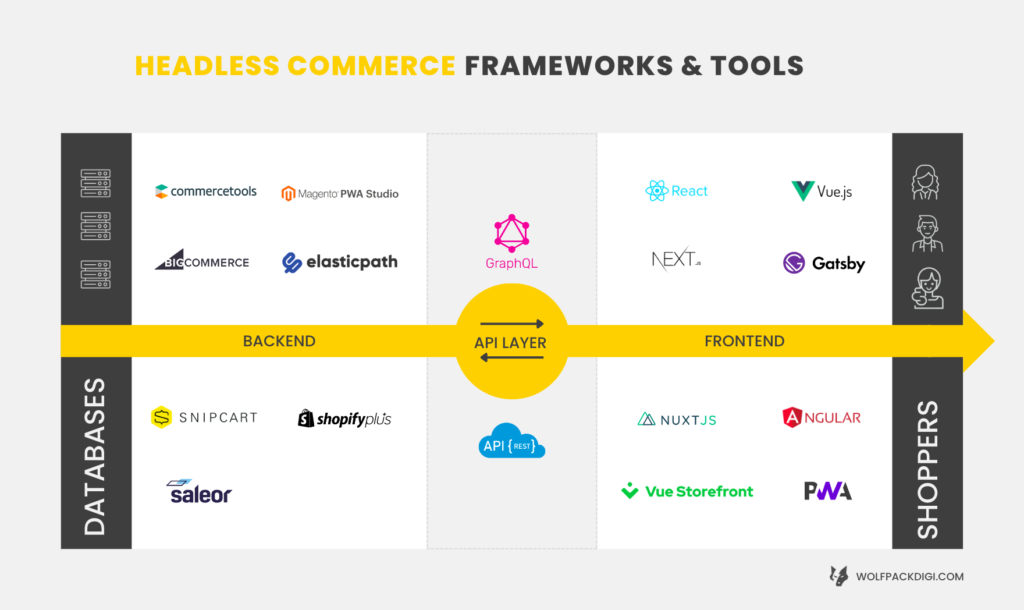
Each of these headless e-commerce tools has its own strengths and weaknesses, and the best one for your business will depend on your specific needs and requirements. It’s important to carefully evaluate each one and compare them based on factors such as customization options, integration capabilities, scalability, security, and support before making a final decision.
Along with the backend tools, which are mentioned above, the headless e-commerce technology also requires a set of front-end tools. A frontend framework is a set of pre-written code, tools, and libraries that developers can use to build the user interface of a website or application. In the context of headless e-commerce, a frontend framework is used to create the user interface that customers interact with when they visit an e-commerce website.
Frontend frameworks for headless e-commerce are typically JavaScript-based, and they allow developers to create reusable UI components and build dynamic user interfaces with ease. Some popular frontend frameworks for headless e-commerce include React, Angular, Vue.js, GatsbyJS, EmberJS and NextJS. These frameworks provide developers with the tools they need to create a seamless and efficient customer experience, such as the ability to handle large amounts of data, create responsive web designs, and optimize for performance.
There are several frontend frameworks that work well with headless e-commerce, here are a few popular ones:
1. React
This is a JavaScript library for building user interfaces. It allows developers to create reusable UI components and build dynamic user interfaces with ease. React is a popular choice for headless eCommerce because of its flexibility, scalability and the ability to easily integrate with other technologies such as GraphQL. There are other tools specifically designed for E-commerce which are built on top of React- such as NextJS and GatsbyJS which makes it a lot easier for business owners to host their businesses online.
2. Vue
This is a progressive JavaScript framework for building user interfaces. Vue.js is lightweight and easy to learn, making it a popular choice for smaller projects or teams that are new to JavaScript frameworks. It also has a built-in reactivity system which allows the developers to easily handle changes in the data and update the UI accordingly. Vue Storefront, Quasar, Gridsome, etc are some e-commerce tools which are built on top of VueJS to provide a seamless experience to business owners.
3. Angular
This is a JavaScript framework for building web applications. Angular is known for its powerful templates and two-way data binding, which makes it a great choice for building complex user interfaces. It’s also popular for headless eCommerce because of its ability to easily handle large amounts of data and its scalability.
The tools mentioned above are just a few examples of front-end frameworks that work well with headless e-commerce. The best one for your project will depend on your specific needs and requirements. It’s important to carefully evaluate each one and compare them based on factors such as ease of use, scalability, and performance before making a final decision.
Conclusion
In conclusion, Headless e-commerce is a newer approach to creating digital shopping experiences that allow for greater flexibility and scalability. It allows businesses to create a unique and personalized shopping experience for their customers, while still leveraging the power and security of a robust e-commerce platform. By choosing the right headless e-commerce platform and integrating it with existing systems, businesses can create a seamless and efficient shopping experience for their customers. Leveraging emerging technologies such as AI and blockchain can also help to improve the speed and security of online shopping experiences.
Are you ready to skyrocket your online marketplace and leave your competition in the dust? Look no further! Integrating headless commerce tools is the secret weapon you need to take your business to the next level.
